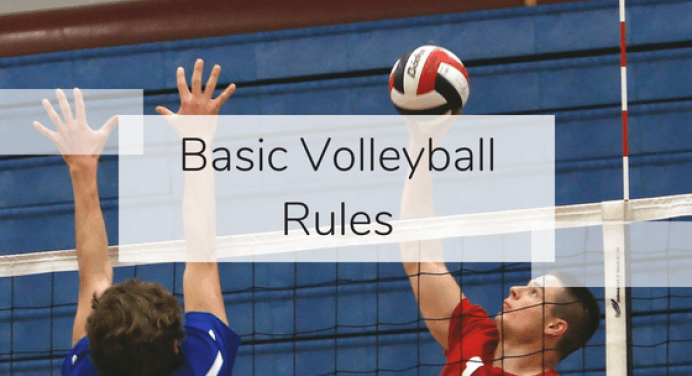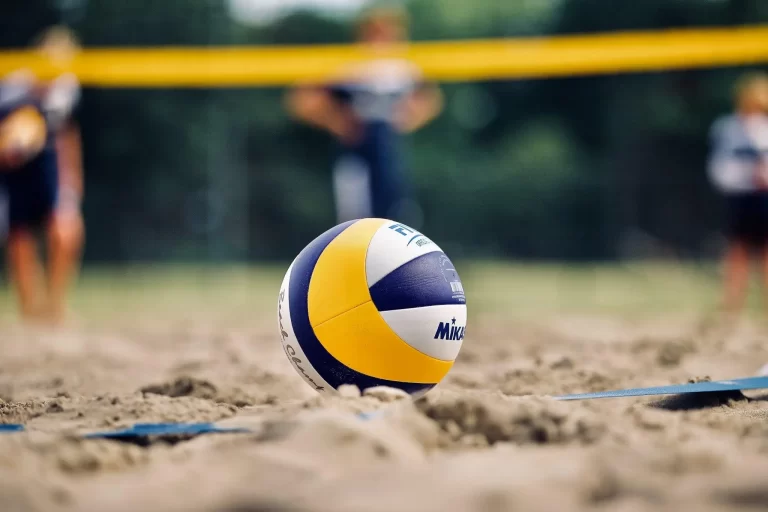Κανόνες του βόλεϊ: 24 κανόνες που πρέπει να γνωρίζει κάθε παίκτης

Το βόλεϊ είναι μια συναρπαστική και γρήγορη δραστηριότητα στην οποία συμμετέχουν και αγαπούν εκατομμύρια άνθρωποι σε όλο τον κόσμο. Η κατανόηση των θεμελιωδών κανόνων του βόλεϊ είναι ζωτικής σημασίας για να παίζετε το παιχνίδι αποτελεσματικά, είτε είστε παίκτης ψυχαγωγίας είτε θέλετε να συμμετάσχετε σε ανταγωνιστικά πρωταθλήματα. Σε αυτό το πλήρες βιβλίο, θα δούμε τους κανόνες των μεθόδων βόλεϊ και τις στρατηγικές που μπορούν να σας βοηθήσουν να ανθίσετε.
Βασικοί κανόνες του βόλεϊ
1. Κανόνες σερβιρίσματος: Έναρξη του παιχνιδιού με ένα Smash
Το πρώτο βήμα σε κάθε αγώνα βόλεϊ είναι το σερβίρισμα. Ένας παίκτης στέκεται πίσω από την τελική γραμμή και πετάει την μπάλα πάνω από το δίχτυ στο αντίπαλο γήπεδο. Πρέπει να καθαρίσει το δίχτυ και να προσγειωθεί εντός των ορίων του γηπέδου της αντίπαλης ομάδας. Οι παίκτες πρέπει να προσέχουν να μην ξεπεράσουν τη γραμμή ενώ σερβίρουν, κάτι που είναι γνωστό ως σφάλμα στα πόδια.

2. Κανόνες περιστροφής: Στρατηγική αλλαγή θέσεων
Αφού κερδίσουν ένα ράλι και αποκτήσουν το δικαίωμα να σερβίρουν, οι παίκτες βόλεϊ πρέπει να ανταλλάξουν θέσεις. Αυτό προάγει τη δικαιοσύνη και εμποδίζει τους παίκτες να συγκεντρωθούν σε μια περιοχή του γηπέδου. Επειδή η περιστροφή είναι αριστερόστροφα, κάθε παίκτης καλύπτει τελικά κάθε θέση στο γήπεδο.
3. Κανόνες χειρισμού μπάλας: Καθαρές και ελεγχόμενες επαφές
Κατά τη διάρκεια του παιχνιδιού, οι παίκτες πρέπει να έχουν καθαρή επαφή με την μπάλα. Διπλά χτυπήματα, στα οποία η μπάλα χτυπά το σώμα ενός παίκτη δύο φορές στη σειρά, δεν επιτρέπονται. Επιπλέον, οι παίκτες δεν επιτρέπεται να πιάσουν, να κρατήσουν ή να πετάξουν την μπάλα. πρέπει να χτυπηθεί καθαρά και να μην σταματήσει τελείως στα χέρια ενός παίκτη.

4. Κανόνες καθαρού: Πέρασμα της γραμμής
Το δίχτυ είναι ένα ουσιαστικό μέρος του παιχνιδιού, αλλά οι παίκτες πρέπει να είναι προσεκτικοί να μην παρεμβαίνουν σε αυτό. Οι παίκτες δεν επιτρέπεται να αγγίζουν το δίχτυ με οποιοδήποτε μέρος του σώματός τους ενώ η μπάλα είναι στο παιχνίδι. Απαγορεύεται επίσης το πέρασμα του διχτυού στο χώρο του αντιπάλου, ακόμη και με πόδι.
5. Κανόνες βαθμολογίας: Σύστημα Πόντων Ράλι
Το βόλεϊ έχει ένα σύστημα βαθμολόγησης πόντων ράλι, που σημαίνει ότι βαθμολογείται ένας βαθμός σε κάθε παιχνίδι. Οι ομάδες μπορούν να κερδίσουν πόντους είτε σερβίρουν είτε λαμβάνουν, επομένως κάθε ράλι είναι κρίσιμο. Το σετ κερδίζεται από την πρώτη ομάδα που θα πετύχει 25 πόντους με πλεονέκτημα δύο πόντων και οι αγώνες είναι συνήθως καλύτεροι των πέντε σετ.
6. Κανόνες εκτός ορίων: Διατήρηση του παιχνιδιού στο παιχνίδι
Η μπάλα πρέπει να παραμένει εντός των ορίων του γηπέδου κατά τη διάρκεια του παιχνιδιού. Εάν προσγειωθεί εκτός των γραμμών του γηπέδου, θεωρείται εκτός ορίων και η αντίπαλη ομάδα κερδίζει έναν βαθμό. Οι παίκτες πρέπει να είναι προσεκτικοί και να αποφεύγουν την επαφή με την μπάλα εκτός των ορίων του γηπέδου.
7. Κανόνες επίθεσης: Spiking με ακρίβεια
Η επίθεση είναι ένας επιθετικός ελιγμός στον οποίο οι παίκτες επιδιώκουν να παραδώσουν την μπάλα δυνατά στο γήπεδο του αντιπάλου τους. Ωστόσο, υπάρχουν ορισμένοι περιορισμοί που πρέπει να τηρούνται: η επίθεση πρέπει να έρχεται πίσω από τη γραμμή των δέκα ποδιών. Οι παίκτες δεν μπορούν να φτάσουν πάνω από το δίχτυ για να χτυπήσουν την μπάλα εκτός και αν μπλοκάρουν. και οι παίκτες της πίσω σειράς δεν μπορούν να κάνουν ακίδα ενώ βρίσκονται μπροστά από τη γραμμή των δέκα ποδιών.

8. Κανόνες αποκλεισμού: Χτίζοντας έναν αμυντικό τοίχο
Το μπλοκ είναι μια κρίσιμη αμυντική κίνηση που χρησιμοποιείται για να σταματήσει την επίθεση του αντιπάλου. Οι παίκτες στα δίχτυα μπορούν να πλησιάσουν και να μπλοκάρουν την μπάλα, αλλά δεν πρέπει να παρεμβαίνουν στο παιχνίδι της αντίπαλης ομάδας. Το μπλοκάρισμα πρέπει να είναι καθαρό και να μην περιλαμβάνει επαφή με το δίχτυ.
9. Κανόνες αντικατάστασης: Πραγματοποίηση στρατηγικών αλλαγών
Οι ομάδες μπορούν να χρησιμοποιήσουν αντικαταστάτες για να φέρουν νέους παίκτες ή να επωφεληθούν από συγκεκριμένους αγώνες. Οι αντικαταστάσεις πρέπει να τηρούν αυστηρές οδηγίες και μπορούν να πραγματοποιηθούν μόνο σε συγκεκριμένες περιόδους παιχνιδιού.
10. Κανόνες λίμπερο: Ο ειδικός της άμυνας
Ο λίμπερο είναι ειδικός στην άμυνα που φοράει ένα χαρακτηριστικό χρώμα φανέλας. Περιορίζονται από το σερβίς ή την επίθεση από την πρώτη σειρά, αλλά υπερέχουν σε αμυντικές ικανότητες και βοηθούν στη σταθεροποίηση της υποδοχής και της πάσας της ομάδας.
11. Βλάβες και παραβάσεις: Κατανόηση παραβάσεων
Όπως κάθε άθλημα, έτσι και το βόλεϊ έχει το μερίδιο του σε σφάλματα και παραβιάσεις. Αυτά μπορεί να περιλαμβάνουν περπάτημα πάνω από την κεντρική γραμμή, άγγιγμα του φιλέ κατά τη διάρκεια του παιχνιδιού ή διάπραξη σφάλματος ποδιού κατά τη διάρκεια του σερβίς. Η κατανόηση αυτών των παραβάσεων είναι ζωτικής σημασίας για να αποφευχθεί η απονομή περιττών πόντων στην αντίπαλη ομάδα.

12. Αποφάσεις Διαιτητή: Σεβασμός στις κλήσεις
Οι διαιτητές βόλεϊ διαδραματίζουν κρίσιμο ρόλο στην επιβολή των κανόνων και στη διασφάλιση του ευγενούς παιχνιδιού. Είναι σημαντικό για τους παίκτες να σέβονται τις αποφάσεις που παίρνουν οι διαιτητές, ακόμα κι αν διαφωνούν με την κλήση.
13. Σήματα χεριών: Αποτελεσματική επικοινωνία
Για να διατηρήσουν απρόσκοπτη επικοινωνία κατά τη διάρκεια ενός αγώνα, οι παίκτες βόλεϊ χρησιμοποιούν χειροκίνητα σημάδια για να υποδείξουν διαφορετικά παιχνίδια και στρατηγικές. Η κατανόηση αυτών των σημάτων είναι ζωτικής σημασίας για αποτελεσματική ομαδική εργασία και συντονισμό.
14. Τάιμ άουτ και προκλήσεις: Τακτικά διαλείμματα
Οι ομάδες μπορούν να καλούν τάιμ άουτ για να ανασυνταχθούν, να οργανώσουν στρατηγική και να ξεκουραστούν κατά τη διάρκεια ενός αγώνα. Επιπλέον, σε ορισμένες μορφές του παιχνιδιού, οι ομάδες μπορεί να έχουν την επιλογή να αμφισβητήσουν ορισμένες αποφάσεις του διαιτητή χρησιμοποιώντας επανάληψη βίντεο.
15. Επιφάνεια παιχνιδιού: Διαστάσεις γηπέδου
Τα γήπεδα βόλεϊ έχουν συγκεκριμένες διαστάσεις και σημάδια που πρέπει να τηρούν οι παίκτες κατά τη διάρκεια του παιχνιδιού. Η κατανόηση της διάταξης του γηπέδου είναι ζωτικής σημασίας για την τοποθέτηση και τη γνώση των ορίων.

16. Κανόνες μπιτς βόλεϊ: Ήλιος, άμμος και ακίδα
Το μπιτς βόλεϊ έχει τους δικούς του κανόνες, συμπεριλαμβανομένων των διαφορών στο μέγεθος του γηπέδου, τον αριθμό των παικτών και την απουσία rotation. Η εξερεύνηση των αποχρώσεων του beach volley μπορεί να προσθέσει μια συναρπαστική ανατροπή στην εμπειρία σας στο βόλεϊ.
17. Διεθνής Ομοσπονδία Πετοσφαίρισης (FIVB): Παγκόσμια Διακυβέρνηση
Η FIVB είναι ο παγκόσμιος κυβερνητικός οργανισμός του βόλεϊ. Η κατανόηση της θέσης τους στην παγκόσμια προώθηση και ρύθμιση του βόλεϊ μπορεί να δώσει χρήσιμες πληροφορίες για την ευρύτερη κοινότητα του βόλεϊ.
18. Κανόνες Βόλεϊ Νέων: Διατροφή Μελλοντικών Πρωταθλητών
Το βόλεϊ νέων έχει συχνά τροποποιημένους κανόνες για να φιλοξενεί νεαρούς παίκτες και να ενθαρρύνει την ανάπτυξη δεξιοτήτων, διατηρώντας παράλληλα ένα ασφαλές και ευχάριστο περιβάλλον για όλους τους συμμετέχοντες.
19. Κανόνες προσαρμοστικού βόλεϊ: Συμμετοχικότητα και Ενδυνάμωση
Το προσαρμοστικό βόλεϊ επιτρέπει σε άτομα με αναπηρία να συμμετέχουν στο άθλημα, με κανόνες προσαρμοσμένους ώστε να ταιριάζουν σε διαφορετικές ικανότητες. Η αγκαλιά του προσαρμοστικού βόλεϊ προάγει τη συμμετοχή και ενδυναμώνει τους παίκτες με διαφορετικές ανάγκες.
20. Εθιμοτυπία βόλεϊ: Καλή αθλητική συμπεριφορά
Πέρα από τους κανόνες, η εθιμοτυπία στο βόλεϊ ενθαρρύνει την καλή αθλητική συμπεριφορά και τον σεβασμό προς τους αντιπάλους, τους συμπαίκτες, τους προπονητές και τους διαιτητές. Η επίδειξη καλής εθιμοτυπίας είναι απαραίτητη για την καλλιέργεια ενός θετικού και ευχάριστου περιβάλλοντος παιχνιδιού.
21. Προπονητική βόλεϊ: Πάθος: Μοιραστείτε τη γνώση και το πάθος
Για όσους ενδιαφέρονται να προπονήσουν βόλεϊ, η βαθιά κατανόηση των κανόνων είναι μόνο η αρχή. Η αποτελεσματική προπόνηση περιλαμβάνει τη μετάδοση γνώσεων, την έμπνευση των παικτών και την καλλιέργεια της αγάπης για το παιχνίδι.
22. Κοινά λάθη: Μαθαίνοντας από τα λάθη
Ακόμη και οι έμπειροι παίκτες κάνουν λάθη, αλλά το να μαθαίνεις από αυτά είναι το κλειδί για τη βελτίωση. Η διερεύνηση κοινών λαθών στο βόλεϊ και ο τρόπος αποφυγής τους μπορεί να βοηθήσει τους παίκτες να βελτιώσουν τις δεξιότητές τους.
23. Ψυχικές όψεις του βόλεϊ: Μένοντας δυνατός
Το βόλεϊ είναι κάτι περισσότερο από μια απλή σωματική δραστηριότητα. Η ψυχική σκληρότητα είναι επίσης σημαντική. Η κατανόηση του πώς να παραμείνετε συγκεντρωμένοι, με κίνητρο και ανθεκτικότητα στο γήπεδο μπορεί να προσφέρει στους παίκτες ένα ανταγωνιστικό πλεονέκτημα.
24. Εργαλείο και εξοπλισμός βόλεϊ: Το οπλοστάσιο ενός παίκτη
Η διερεύνηση του απαραίτητου εξοπλισμού και του εξοπλισμού που απαιτείται για το βόλεϊ, όπως κατάλληλα παπούτσια, επιγονατίδες και ρούχα, μπορεί να βελτιώσει την απόδοση ενός παίκτη και να εξασφαλίσει ασφάλεια κατά τη διάρκεια του παιχνιδιού.
Ακολουθούν ορισμένοι πρόσθετοι κανόνες που μπορεί να σας φανούν χρήσιμοι:
Παιχνίδι
Σερβίρισμα
Το παιχνίδι ξεκινά με ένα σερβίς, όπου ένας παίκτης στέλνει την μπάλα πάνω από το φιλέ στο γήπεδο της αντίπαλης ομάδας. Ο διακομιστής πρέπει να στέκεται πίσω από την τελική γραμμή και να σερβίρει την μπάλα κάτω ή από πάνω.
Πέρασμα
Όταν η μπάλα έρχεται σε έναν παίκτη, χρησιμοποιούν την πάσα του αντιβραχίου ή την εναέρια πάσα για να την κατευθύνουν στον συμπαίκτη τους. Η πάσα είναι μια κρίσιμη ικανότητα για τη διατήρηση του ελέγχου κατά τη διάρκεια του παιχνιδιού.
Σειρά
Το σετ είναι το δεύτερο άγγιγμα της μπάλας από μια ομάδα και περιλαμβάνει την τοποθέτηση της μπάλας για ακίδα. Απαιτεί ακριβείς και απαλές πινελιές για να προσφέρει ένα τέλειο σετ στο spiker.
Ακίδα
Η ακίδα, γνωστή και ως επίθεση, είναι ένα δυνατό χτύπημα που προσπαθεί να κερδίσει έναν πόντο στέλνοντας την μπάλα πάνω από το δίχτυ και στο αντίπαλο γήπεδο. Οι αιχμές απαιτούν ακριβή χρονισμό και τεχνογνωσία για να είναι επιτυχείς.
ΟΙΚΟΔΟΜΙΚΟ ΤΕΤΡΑΓΩΝΟ
Το μπλοκ είναι μια αμυντική κίνηση όπου οι παίκτες πηδούν στο φιλέ για να ανακόψουν την προσπάθεια ακίδας του αντιπάλου. Το αποτελεσματικό μπλοκάρισμα μπορεί να διαταράξει τη στρατηγική επίθεσης του αντιπάλου.
Σκάβω
Το σκάψιμο είναι μια αμυντική κίνηση που χρησιμοποιείται για να αποτρέψει την μπάλα να χτυπήσει στο έδαφος μετά από μια ισχυρή ακίδα. Οι παίκτες βουτούν ή γλιστρούν για να κρατήσουν την μπάλα στο παιχνίδι.
Συχνές ερωτήσεις
Ε: Τι συμβαίνει εάν ένας παίκτης αγγίξει το δίχτυ κατά τη διάρκεια του παιχνιδιού;
Α: Εάν ένας παίκτης έρθει σε επαφή με το δίχτυ κατά τη διάρκεια του παιχνιδιού, θεωρείται παράβαση και η αντίπαλη ομάδα παίρνει έναν βαθμό.
Ε: Μπορεί ένας παίκτης της πίσω σειράς να εκτελέσει επίθεση από το μπροστινό μέρος της γραμμής των δέκα ποδιών;
Α: Όχι, οι παίκτες της πίσω σειράς δεν επιτρέπεται να επιτίθενται από το μπροστινό μέρος της γραμμής των δέκα ποδιών.
Ε: Πόσοι παίκτες είναι σε μια ομάδα μπιτς βόλεϊ;
Οι ομάδες μπιτς βόλεϊ αποτελούνται συνήθως από δύο παίκτες σε κάθε πλευρά.
Ε: Μπορούν να γίνουν αντικαταστάσεις οποιαδήποτε στιγμή κατά τη διάρκεια ενός αγώνα;
Αλλαγές μπορούν να γίνουν μόνο σε συγκεκριμένες διακοπές στο παιχνίδι, ακολουθώντας τους κανόνες του παιχνιδιού.
Ε: Υπάρχουν διαφορές στους κανόνες μεταξύ βόλεϊ εσωτερικού και μπιτς;
Α: Ναι, υπάρχουν αρκετές διαφορές στους κανόνες μεταξύ του βόλεϊ εσωτερικού και του μπιτς βόλεϊ, όπως το μέγεθος του γηπέδου, ο αριθμός των παικτών και οι κανόνες εναλλαγής.
Ε: Μπορεί ένας παίκτης να χτυπήσει την μπάλα δύο φορές συνεχόμενα κατά τη διάρκεια ενός ράλι;
Α: Όχι, οι παίκτες δεν επιτρέπεται να κάνουν διαδοχικές επαφές με την μπάλα, γνωστές ως διπλό χτύπημα, κατά τη διάρκεια ενός ράλι.
συμπέρασμα
Το βόλεϊ είναι ένα απίστευτο άθλημα που προσφέρει ενθουσιασμό, ομαδική εργασία και αίσθηση επιτυχίας. Η κατανόηση των κανόνων του βόλεϊ είναι θεμελιώδης για να γίνεις ικανός και επιτυχημένος παίκτης. Από το σερβίς και το σκοράρισμα μέχρι τα rotations και το μπιτς βόλεϊ, αυτός ο περιεκτικός οδηγός καλύπτει όλα όσα πρέπει να γνωρίζετε για τους κανόνες που διέπουν αυτό το δυναμικό παιχνίδι. Πάρτε λοιπόν τον εξοπλισμό σας, πάτε στο γήπεδο και απολαύστε τη συγκίνηση του βόλεϊ καθώς παίζετε σύμφωνα με τους κανόνες και επιδεικνύετε την εμπειρία σας σε αυτό το συναρπαστικό άθλημα.






